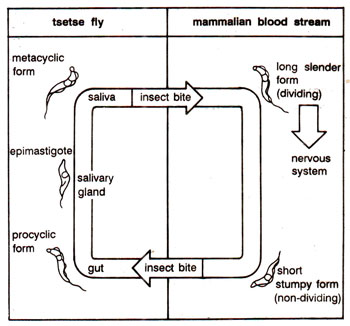Trypanosome surface antigen (VSG) switching

Fig. 37.19. Life cycle of a trypanosome alternating between two hosts (tsetse fly and a mammal) causing sleeping sickness.

Fig. 37.19. Life cycle of a trypanosome alternating between two hosts (tsetse fly and a mammal) causing sleeping sickness.
Genes (about 1000) for ~ 100 different VSGs are present scattered on different chromosomes in the genome of trypanosome. Diversity, therefore, depends on changing expression from one pre-existing gene to another. Each VSG is coded by a single basic copy gene, which may be telomeric or internal in location, and there may be several isogenes for same VSG or similar VSGs. The copy of the gene, which is active, is called expression linked copy (ELC) and is located on an expression site. Creation of an ELC may involve transfer of a basic copy gene to the expression site or vice versa. Almost all switches in VSG type involve replacement of the ELC by a pre-existing silent copy.




